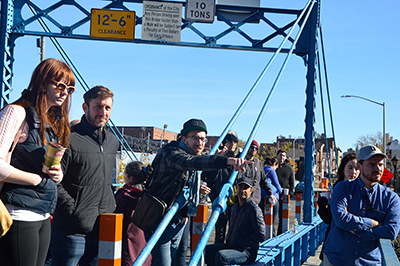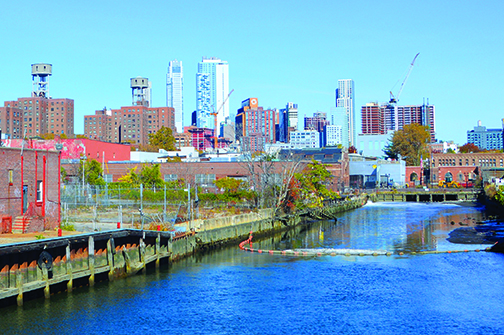Walking the Gowanus From Solid Waste to New Lifeforms – the Hidden Secrets of the Gowanus Canal

I’ve never been to the Gowanus. Until recently, the area has been stuck with a very bad reputation. A dangerous, deserted place, centered around a stinky canal filled with toxic industrial waste, also rumored to be the dumping ground for dead bodies by the Italian Mafia. Bullets Over Broadway, anyone? So I’ve stayed away. Until I heard about Brooklyn Brainery’s “Walk the Gowanus with a Local Author,” and I decided the time was ripe to pay a visit and see for myself. Surely I would be safe in broad daylight, with a well-reputed local guide and 20 witnesses?
[pullquote]Wildlife is starting to return to the canal, as a result of the cleaning efforts. Oysters, white perch, herring, striped bass, anchovies, jellyfish, crabs, herons, egrets, bats, and Canada geese, have all been found in the area. [/pullquote]For $20, licensed New York City tour guide and self-proclaimed history nerd Joseph Alexiou will tell you everything you’ve ever wanted to know about the Gowanus. And if you are left with an appetite for more, Alexiou just happens to be the author of the book Gowanus: Brooklyn’s Curious Canal, conveniently for sale at the Gowanus Souvenir Shop where we met up for the tour on the beautiful Saturday morning in late Fall. Souvenir shop? Yes, the area is now a thriving neighborhood with arts and craft shops, coffee shops, delis and a recently opened Wholefoods. Armed with cups of freshly brewed coffee, courtesy of the souvenir shop, we started the tour by heading down to the Union Street Bridge overlooking the Gowanus Canal.
It’s hard to visualize that the stinky puddle below us was once a riverbed embraced by luscious, green banks, but 400 years ago we would have overlooked a tidal inlet of navigable creeks in original saltwater marshland and meadows with plenty of fish and wildlife. Early European settlers are said to have named the waterway “Gowane’s Creek” after Gouwane, the tribal chief of a local Lenape tribe called the Canarsee, who lived and farmed on the shorelines.
Gradually “Gowane’s Creek” became scattered with tide-water mills, as more settlers moved in. In fact, the first tide-water gristmill ever patented in New York, in 1665, just a year after New Amsterdam got re-named, was built and operated in the Gowanus, in the small town of Breukelen. Dutch farmers also engaged in the clamming of large oysters, which became Breukelen’s first export to Europe. Six-foot tides forced salt water up into the creek’s winding course, creating a brackish mix ideal for oysters. The Gowanus oysters were notable for their large sizes, much bigger than the ones found in the surrounding East Coast area today, and some were even said to have reached the size of dinner plates. When the 19th-century industrial revolution reached the city of Brooklyn, it was the third most populous city in America, as well as the fastest growing. The Gowanus Creek and the farmland had been incorporated the into a greater urban area, and industrial sites had been established among the mills, along with prospering urban villages. The riverbed had already been dredged to get more water to the gristmills, but a canal would serve the inland industries better, and drained surrounding marshes would allow land reclamation to give room for the up to 700 new buildings being constructed annually from this time and into the next century. In 1849, the New York Legislature authorized the construction of the Gowanus Canal. Once completed 20 years later, the new canal allowed for a large number of factories, warehouses, tanneries, coal stores, and oil and gas refineries to spring up as a result. Brownstone quarried in New Jersey and Upstate New York was transported on barges to build the neighborhoods of Carroll Gardens, Cobble Hill, and Park Slope. After World War I, six million tons of cargo was produced and trafficked though the waterway annually. The Gowanus Canal, despite it’s modest size, became the nation’s busiest commercial canal. Standing on the Union Street Bridge and looking down at the docks on either side, we can only imagine the busy hub that must have surrounded us if we had stood there during Brooklyn’s flourishing industrial era. But looking closer at what’s left today, we turn to our guide to find out about a few peculiarities—where is that waterfall coming from down the side of the canal? Why does the canal end in four square holes? What is that strange white froth, trapped in the middle of the waterway? But most importunate, as we are trying to breath through our mouths – why does the water stink so much?
When the canal was planned, the city opted for the cheapest construction, which ended up having several flaws. The canal is open at one end only, because the tide itself was thought to be enough to oxidate the water sufficiently, as well as cleanse the canal from waste. However, the canal’s wooden and concrete embankments barred the tide from flowing all the way into the narrow channel. The concentration of oxygen ended up being just 1.5 parts per million, well below the minimum 4 parts per million needed to sustain life. As a result, boats entering the canal were instantly cleansed of all marine parasites attached to their hulls, but the canal had become an odor-reeking sewer. It was not only because the chemical plants and factories for paint, ink, and soap and sulfur producers by the canal let out their raw sewage straight into the water, but in order to manage Brooklyn’s rapid growth, new sewer connections added to the problem by discharging sewage from the surrounding neighborhoods further away into the Gowanus. The four large square openings in front of us was the outlet of the combined rain water drainage and sewage system known as the “Big Sewer.” It started from Prospect Park and went through an area known as “The Flooded District” with the double purpose of draining the flooded water, and move the still water of the upper Gowanus Canal. Unfortunately, it only brought more dirt into the canal, and even made headlines in the Brooklyn Daily Eagle newspaper shortly after, being described as an engineering blunder. Locals sarcastically nicknamed the canal “Lavender Lake.”

The canal got so polluted with toxins and sludge that regular dredging was required to even keep the waters navigable, and by 1910, the water of the canal was said to have become almost solid waste, which prompted another attempt to bring water into the upper part of the canal. This time a tunnel was constructed to pump clean water from Buttermilk Channel between the Brooklyn shore and Governors Island. However, the Flushing tunnel, as it was named, never functioned properly. The canal and it’s water returned to a neglected, stagnant stage from the 1960s until 1999, when the pump was repaired and re-activated. The waterfall on our left is the result of the new design, pumping an average rate of 200,000,000 US gallons of water into the canal every day, during it’s 11 hours of operation between tides.
A number of cleansing efforts began in the new millennium, and in 2010 the Gowanus Canal was declared a Superfund cleanup site. The Superfund is a trust fund to cover the cost of cleanups, before being reimbursed by the parties responsible for the pollution by referring to the U.S. Department of Justice. Many of the Gowanus polluters have ceased to exist, merged, changed names, or moved away. The successor companies and the current property owners will assume the liability of those sold or merged. Two major polluters identified by the Superfund to be held responsible are New York City and National Grid.
The froth trapped between the bridge and the end of the canal is toxins brought up to the surface and regularly removed from the canal as part of the cleansing effort. But amazingly, new life has also been discovered on the bottom of the canal. A mix of bacteria, protozoa, chemicals, and other substances called “white stuff,” or “bio-film,” appears to collaborate to find food. Even more astonishingly, the biological components exchange genes and expel substance which acts as an antibiotic to keep it protected from toxins in the water. The substance could find use in new antibiotic drugs, and time will tell what more secrets the canal may reveal as the cleanup continues. But for now, the rising gas bubbles from the decomposition of sewage sludge on the bottom still stink up the area on warm and sunny days, like this lovely day we chose for our guided tour.
There are seven bridges over the canal, and as we are crossing the next bridge down, the old, retractile Carroll Street bridge built in 1889, we get a glimpse of how the Gowanus may look in the not-so-distant future. Looking up at a shiny new 700-rental luxury complex from the landmark bridge over the muddy canal, it is as we are seeing two different worlds placed next to each other, which have failed to morph in to one. The building is flanked by photographs advertising a lifestyle of picturesque canoeing in the canal for prospective renters. However, from our perspective on the bridge, the canal looks nothing like it does in the photographs. But there is in fact a canoe club called The Gowanus Dredgers Canoe Club, run by dedicated volunteers, that has logged over 2,000 trips on the Gowanus Canal and report a rise in popularity. And wildlife is starting to return to the canal, as a result of the cleaning efforts. Oysters, white perch, herring, striped bass, anchovies, jellyfish, crabs, herons, egrets, bats, and Canada geese, have all been found in the area. The only wildlife we’re seeing though is a lonely cat, and canoeists should be warned that the water is heavily contaminated by E. coli and gonorrhea. Needless to say, nothing caught in the canal is safe to eat. But as the cleanup continues, the real world may soon enough look like the idealized world in the photographs.
After the tour is over, we are left with an abundance of information to process. The neighborhood around us has more dimensions now, with our extended knowledge about its past. For anyone curious about the Gowanus, the tour gives a fun, upbeat experience, and offers numerous insights into the area’s rich history along the way. And as it is rapidly changing, it may be wise to do the tour soon, while the gritty parts are still there. Also, a winter tour may lessen your chances of having to endure one prominent part of the canal’s history that nobody will be sad to see disappear – the stink.
All photographs by Annika Andersson
